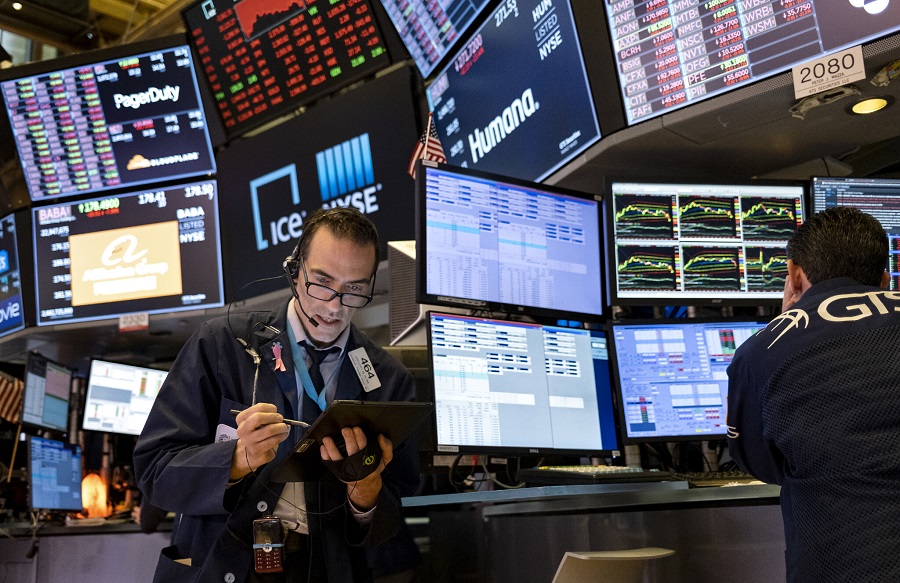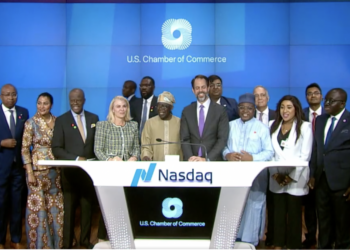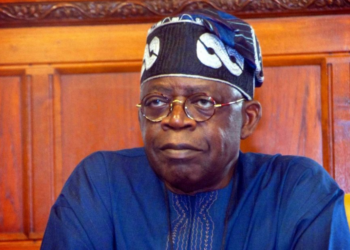Wall Street’s top indexes bounced back from a steep sell-off at the start of the session to close higher on Monday, with bargain hunters pushing the indexes into positive territory by the closing bell, in a successful last-minute attempt to close the day in the green.
The S&P 500 index, at the start of the session, came close to confirming a correction by appearing on track to close more than 10% down from its most recent all-time high which it attained on the 3rd of January 2022, as investors focused on concerns about an increasingly hawkish Federal Reserve and geopolitical tensions.
The S&P 500 miraculously gained 4.3% from its session low to its closing level, the largest upward swing since March 26, 2020, when Wall Street was bouncing back from the global slump caused by the coronavirus pandemic.
What you should know
- The Dow Jones Industrial Average gained 0.29%, to end the session at 34,364.5 basis points, the S&P 500 gained 0.28%, to close the session at 4,410.13 basis points and the Nasdaq Composite also gained 0.63%, to end the session at 13,855.13 basis points.
- Earlier in Monday’s trading session, the major indexes were all more than 2% lower. The S&P appeared to be on course to confirm a correction, and the Russell 2000 looked as if it would confirm it was in a bear market.
- This abrupt, late-session U-turn came in the wake of S&P 500 and the Nasdaq suffering their largest weekly percentage plunge since March 2020, when shutdowns to contain the pandemic sent the economy spiralling into its steepest and most abrupt recession on record.
- All 11 major sectors of the S&P 500 spent most of the trading day deep in red territory, but by market close all but three were green. Consumer discretionary enjoyed the largest percentage gain.
- Fourth-quarter reporting season is in full swing, with 65 of the companies in the S&P 500 having posted results. according to data from Refinitiv, of the companies whose results are out, 77% have come in above expectations. On aggregate, analysts now see S&P 500 annual EPS growth of 23.7%, according to Refinitiv.
- A series of disappointing earnings from big banks and, notably, the decline experienced with Netflix, have overshadowed many better-than-expected results.
- Shares of International Business Machines gained more than 6% in after-hours trading after the company beat revenue expectations on the strength of its cloud and consulting businesses.
- Kohl’s Corp also surged after Reuters reported private equity firm Sycamore Partners is preparing to make a bid for the department store chain days after a consortium backed by activist investment firm Starboard Value proposed a buyout.
- Volume on U.S. exchanges was 18.42 billion shares, compared with the 10.95 billion averages over the last 20 trading days.
Other factors affecting Wall Street’s performance
The U.S. Federal Reserve is due to convene its two-day monetary policy meeting on Tuesday, and market participants will be looking towards the concluding statements and Chairman Jerome Powell’s subsequent Q&A session for clues as to the central bank’s timeline for hiking key interest rates to combat inflation.
In other news affecting Wall Street’s performance, there is signs that geopolitical tensions are heating up. NATO announced it was putting forces on standby to prepare for a potential Russian invasion of Ukraine. The threat of potential conflict in that region helped U.S. Treasury yields dip, pausing their recent upward climb, which has pressured stocks in recent months.
What they are saying about the market
Jake Dollarhide, chief executive officer of Longbow Asset Management stated, “Correction territory is often a psychological sweet spot for investors. They see the correction, and they see that it’s a healthy part of the markets. When everything started selling off, that got a lot of people’s attention, so I think we had what I would call intraday capitulation, getting some of this easy money out of the market.”
Sam Stovall, chief investment strategist of CFRA Research stated, “I think investors are over-assuming a very hawkish stance by the Fed. Granted, inflation is high and is likely to get higher before it starts to decline. Specifically, we see the headline CPI topping at 7.3% for both January and February, but then coming down to 3.5% by year-end.”
















